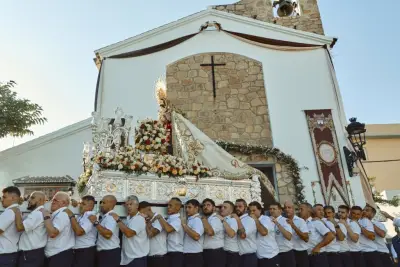Tradition and faith meet at the coast in Spain every July to celebrate the patron of sailors

ESTEPONA Spain AP Silence falls on the beach in the former fishing village of Estepona as the sun sets over Spain s southern coast Barefoot men in white shirts carry a seven-foot statue of the Virgen del Carmen or Our Lady of Mount Carmel adorned with flowers across the sand Children climb on their parents shoulders while others record on their phones standing waist-deep in the sea Offshore boats filled with families and friends await the Virgin s arrival As the statue reaches the shore more than men countless from fishing families lift her onto traditional boats and she sets out to sea Hundreds of vessels from jet skis to paddleboards and fishing boats join the procession chanting and humming in their belief that the Virgin blesses the waters Every July coastal communities across Spain honor the Virgin saint of sailors and protector of those at sea who was also named official patron of the Spanish Navy in It is one of the myriad Marian titles venerated by the Catholic faithful In Estepona once a humble fishing village on the Malaga coast it s the greater part anticipated day of the year Chosen people won t swim until the Virgin enters the water says Isabel Moreno secretary of the Hermandad del Carmen in Estepona the Catholic religious brotherhood that organizes the event Everyone wants to be close to her She protects our fishermen our neighbors our visitors all of us It began in Estepona in when six sailors acquired the statue to bring this Catholic tradition closer to their town Since then it s grown into a full-day celebration that starts with an outdoor Mass sea-themed games and this year for the first time a women s boat race One popular contest called cuca a challenges young men to walk across a greased wooden beam suspended from a boat to grab a flag before falling into the water The statue leaves its chapel in the evening and is carried through the streets as residents throw flower petals sing traditional songs known as coplas and call her estrella de los mares Spanish for star of the seas She sails along the coast then returns to land before being brought back to her chapel This used to be a celebration only for sailors says Alfonso Ram rez head of the brotherhood and son of one of its founders Now it belongs to everyone In modern years he says organizers have worked to make the town feel included regardless of fishing roots Estepona like various Spanish coastal towns has been transformed by tourism In summer its population doubles from to nearly Artisan fishing has declined say captains at the maritime club unable to compete with industrial fleets and increasingly threatened by invasive species like Asian seaweed which has severely impacted the country s marine biodiversity for years To make up for the loss of income from fishing countless boats that once caught anchovies now carry tourists instead But for one night each year Estepona returns to its roots with faith and memory filling the streets and the seaside Past midnight Ana Ruiz sits outside her home in one of Estepona s oldest neighborhoods She watches the procession return to the small chapel where the Virgin will rest until next year We were all fisherfolk and had a humble life says Ruiz whose late husband carried the Virgin for years Now my neighbors are all foreigners But we want them to love our Virgin too Associated Press religion coverage receives encouragement through the AP s collaboration with The Conversation US with funding from Lilly Endowment Inc The AP is solely responsible for this content Source


